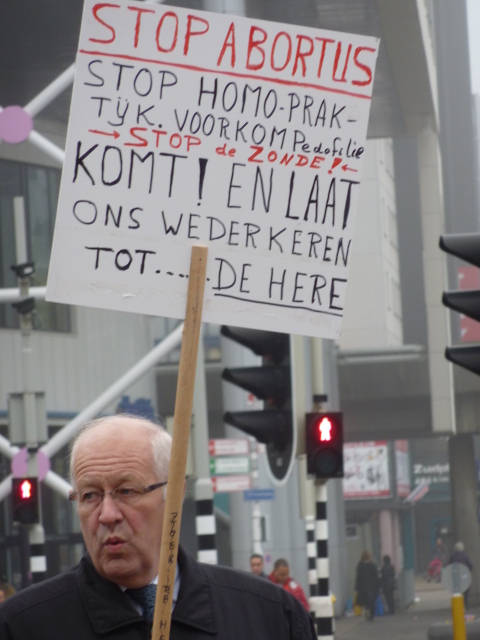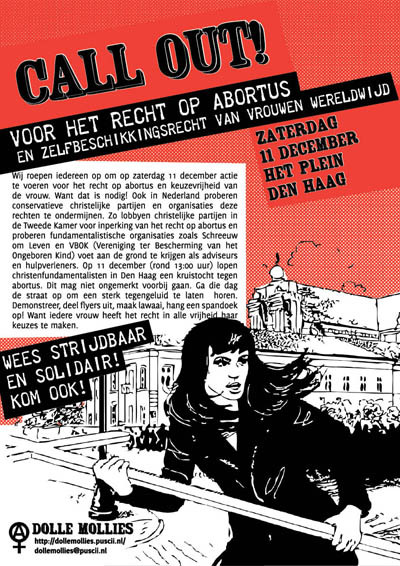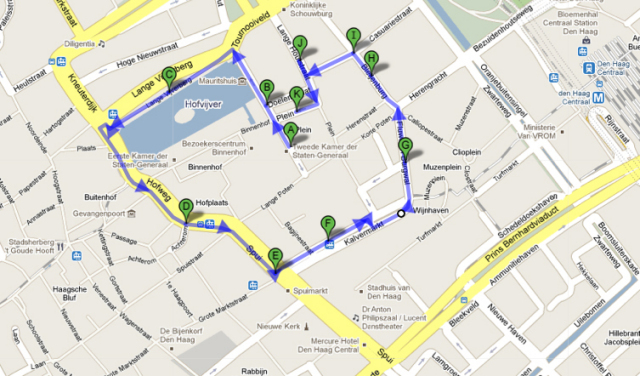|
|  |
| Feminists for Life | Feminist - 05.12.2010 22:29
The abortion debate is full of horror stories on both sides of the issue. Coercive and unethical counselors lie to vulnerable women and pressure them. This has happened in some abortion clinics as well as some pregnancy care centers. Women have died from botched abortions, both before abortion was legalized and after, when it is supposed to be safe. Fanatics resort to violence on both extremes of the pro-choice/pro-life spectrum.
Focusing on these isolated incidents and extreme cases makes for effective fund-raising. What it does not do is help women - which was what the original feminist movement set out to do. In the 1960's, certain factions of the women's movement made a drastic about-face.
The feminist movement was born more than two hundred years ago when Mary Wollstonecraft wrote "A Vindication of the Rights of Women." After decrying the sexual exploitation of women, she condemned those who would "either destroy the embryo in the womb, or cast it off when born." Shortly thereafter, abortion became illegal in Great Britain.
The now revered feminists of the 19th century were also strongly opposed to abortion because of their belief in the worth of all humans. Like many women in developing countries today, they opposed abortion even though they were acutely aware of the damage done to women through constant child-bearing. They opposed abortion despite knowing that half of all children born died before the age of five. They knew that women had virtually no rights within the family or the political sphere. But they did not believe abortion was the answer.
Without known exception, the early American feminists condemned abortion in the strongest possible terms. In Susan B. Anthony's newsletter, The Revolution, abortion was described as "child murder," "infanticide" and "foeticide." Elizabeth Cady Stanton, who in 1848 organized the first women's rights convention in Seneca Falls, New York, classified abortion as a form of infanticide and said, "When you consider that women have been treated as property, it is degrading to women that we should treat our children as property to be disposed of as we see fit."
Anti-abortion laws enacted in the latter half of the 19th century were a result of advocacy efforts by feminists who worked in an uneasy alliance with the male-dominated medical profession and the mainstream media. The early feminists understood that, much like today, women resorted to abortion because they were abandoned or pressured by boyfriends, husbands and parents and lacked financial resources to have a baby on their own.
Ironically, the anti-abortion laws that early feminists worked so hard to enact to protect women and children were the very ones destroyed by the Roe v. Wade decision 100 years later - a decision hailed by the National Organization for Women (NOW) as the "emancipation of women."
The goals of the more recent NOW-led women's movement with respect to abortion would have outraged the early feminists. What Elizabeth Cady Stanton called a "disgusting and degrading crime" has been heralded by Eleanor Smeal, former president of NOW and current president of the Fund for a Feminist Majority, as a "most fundamental right."
Betty Friedan, credited with reawakening feminism in the 1960's with her landmark book, The Feminine Mystique, did not even mention abortion in the early edition. It was not until 1966 that NOW included abortion in its list of goals. Even then abortion was a low priority.
It was a man - abortion rights activist Larry Lader, who remains active today - who credits himself with guiding a reluctant Friedan to make abortion an issue for NOW. Lader had been working to repeal the abortion laws based on population growth concerns, but state legislators were horrified by his ideas. (Immigration and improved longevity were fueling America's population growth - not reproduction, which in fact had declined dramatically.)
Lader teamed up with a gynecologist, Bernard Nathanson, to co-found the National Alliance to Repeal Abortion Laws, the forerunner of today's National Abortion and Reproductive Rights Action League (NARAL).
Lader suggested to the NOW leadership that all feminist demands (equal education, jobs, pay, etc.) hinged on a woman's ability to control her own body and procreation. After all, employers did not want to pay for maternity benefits or lose productivity when a mother took time off to care for a newborn or sick child. Lader convinced the NOW leadership that legalized abortion was the key to the workplace.
Dr. Nathanson, who later became a pro-life activist, states in his book, Aborting America, that the two were able to convince Friedan that abortion was a civil rights issue. Later he admitted that they simply made up the numbers of women dying from illegal abortions, which had been a major point in their argument.
Lader's and Nathanson's strategy was highly effective. NOW has made the preservation of legal abortion its number one priority. Its literature repeatedly states that access to abortion is "the most fundamental right of women, without which all other rights are meaningless."
With this drastic change, a highly visible faction of the women's movement abandoned the vision of the early feminists: a world where women would be accepted and respected as women. There are now 1.3 million surgical abortions per year in the United States. The Alan Guttmacher Institute (the research arm of Planned Parenthood) reports that women have abortions for two primary reasons: lack of financial resources and lack of emotional support.
Feminists for Life of America recognizes that abortion is a symptom of, not a solution to, the continuing struggles women face in the workplace, at home and in society. Our emphasis is on addressing root causes and promoting solutions - from prevention to practical resources.
The first step is to empower young women and men to make life-affirming choices. No compassionate person, pro-choice or pro-life, wants to see a teenage girl drop out of school and face a lifetime of poverty because she became pregnant. Nor do we want her to suffer the pain and anguish of abortion. Public and private funding for comprehensive programs that emphasize teen pregnancy prevention must be increased dramatically. We need honest and unbiased evaluation and replication of effective programs that include proven strategies such as life-planning skills training and mentoring. Boys, as well as girls, should be included in the remedy.
Groups like Feminists for Life and pregnancy resource centers regularly get calls from women who are pressured by partners who say they will pay $300 for an abortion but won't pay a dime in child support. Men and boys need to know that, thanks to legislation supported by Feminists for Life and other women's organizations that strengthens child support enforcement and paternity establishment, they can no longer coerce women into having an abortion by threatening to abandon their children if they are born. But fathers need to do more than make payments. Their presence is needed in their child's life. For women whose partners are absent and who are unable to provide for their children, assistance must come from both private and public sources to protect children by providing the basis, including affordable, quality child care, and education and employment opportunities for the mother.
If we are serious as a nation about significantly reducing the number of abortions, then established, credible pregnancy resource centers should be eligible for federal funding. Nearly 4,000 pregnancy care centers and maternity homes guide women in crisis through the maze of available support services - food, clothing, housing, furniture, medical care including high risk pregnancies, legal assistance, help with employment and education, drug abuse and domestic violence counseling, childbirth, breast-feeding and parenting classes - all at no charge. Some specialize in bilingual/bicultural services, adoption and/or post-abortion counseling. These centers are where many pro-lifers "walk their talk" to help women in need. They leverage financial and in-kind resources from individuals, businesses, churches and communities across the country, yet they cannot consistently meet the demand for services.
Although these centers are clearly listed in the yellow pages as "abortion alternatives," some abortion advocates have resorted to calling them "fake clinics" to discredit their efforts to give women choices other than abortion. Coercive techniques, lies, and other unethical practices should not be tolerated in abortion clinics or in pregnancy resource centers. While the vast majority of pregnancy resource centers such as those affiliated with Catholic Charities and Birthright, and the vast majority of not-for-profit abortion providers do not engage in these unethical practices - some for-profit abortion clinics and unaffiliated pregnancy care centers may stray from the ethical path. NARAL is currently working to expose those anti-abortion centers that resort to lies and lurid pictures; NARAL should also expose those abortion clinics that try to convince women they have no choices other than abortion.
One model program is First Resort of California. Founder Shari Plunkett approached HMO Kaiser Permanente with a plan to reduce the number of abortions in the Bay area. After thoroughly reviewing the program - even editing brochures - Kaiser agreed to refer clients who were unsure about having an abortion to First Resort. Kaiser's client satisfaction rate was 99.3%. When NARAL's California affiliate (CARAL) succeeded in pressuring Kaiser to terminate the program, women lost the ability to make an informed choice. CARAL ignored an invitation to meet with staff and tour First Resort.
Across the country, Americans on both side of the abortion debate agree that women have a right to make informed decisions about their pregnancy. We can empower women to exercise this right by passing "Right to Know" legislation. As with any other medical procedure, women have a right to full disclosure of the nature of the abortion procedure, risks and potential complications and alternative support services, as well as the father's responsibility. A woman has the right to know her doctor's name, whether he/she will be available if a medical emergency emerges, any history of malpractice in any state or revocation of a medical license; she has the right to a fully equipped clinic and/or ambulance nearby in case of complications, and the right to redress if she is hurt by the abortion. Even veterinary clinics are better regulated than abortion clinics, for which there are no uniform inspections or reporting requirements. Doctors who have botched abortions, caused infertility or death and lost their medical licenses have been known to jump state lines to continue providing abortions and even open new clinics. There are no regulations to stop them.
Employers and educational institutions can also implement policies that ensure meaningful options for pregnant and parenting women (as well as parenting men). Women in the workplace should not have to choose between their child and their job. That is no choice at all. Employers who have not already done so should consider flex time, job sharing, on-site child care and telecommuting. Women need maternity coverage in health care; men and women need parental leave. Living wages would enable parents to support their children.
Similarly, women should not be forced to choose between their education and life plans and their child. As Feminists for Life has expanded its College Outreach Program in recent years, a number of college counselors have told us the only choice they are aware of is between various abortion clinics - as if women are not capable of reading or thinking while they are pregnant or parenting. Feminists for Life is leading forums on college campuses that challenge university officials to provide housing, on-site child care and maternity coverage within student health care plans, and inform women about their hard-won right to child support. We have developed comprehensive Pregnancy Resources Kits with the input of those on both sides of the debate - including abortion doctors, pro-choice clinic staff, attorneys and students - to give women the "rest of the choices."
Even though Feminists for Life has reached out to pro-choice activists to help provide more choices for women, ironically, Planned Parenthood, the nation's largest abortion provider, has called Feminists for Life's solution-oriented program "anti-choice."
If providing practical resources that help women can be called "anti-choice," something has gone terribly wrong. It is time to set aside the rhetoric and horror stories and fund-raising tactics and think again about how we can help women in need.
 http://www.feministsforlife.org/news/commonw.htm http://www.feministsforlife.org/news/commonw.htm
| | Why? | nn - 05.12.2010 22:42
And why did you copy-paste this rant on indymedia under this post to fight for the right of abortions. Women should have the right for safe abortions and this demo will stand up for that!
| | pro-life christanity & reality | MM - 05.12.2010 23:07
And then these so-called Christian doctors in countries where abortion is forbidden, sometimes STERILIZE a child woman of 13 after being raped and having giving obliged born to an unwanted baby, to fore-come more future problems.
| | schreeuw om leven homohaters | humanrights - 06.12.2010 12:53

onderstaande schreeuw om leven aanhanger leukt met zijn homohaat regelmatig anti abortus demos op
| |
| aanvullingen | |





